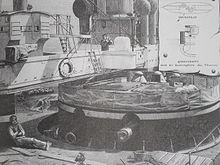Turntable mount

A turntable mount is a type of mount that enables a gun to be aimed from the side . It was particularly used on warships in the second half of the 19th century and in coastal artillery.
The fixed guns used in fortresses up to the 19th century were usually ineffective in the lateral directional area, as the block mounts used until then were not equipped for this. The lateral direction could only be done very imprecisely by lifting the entire carriage. In the case of ships that had the cannons set up across the direction of travel in a broadside, the whole ship had to be aimed roughly. For battles on land as well as at sea, however, a larger sweep angle and a higher target speed were required. Among other things, this led to the concept of the tower ship in shipbuilding .
A lateral pivoting of the gun - up to 360 degrees - was possible with the so-called pivot setup . However, the pivot pin has to absorb both axial and radial forces. However, especially before the introduction of effective pipe return systems , these forces were structurally difficult to control. A second pair of wheels has been added to the center pivot mount and the pivot bolt is placed in the middle between the pairs of wheels. This relieved the pivot bolt of axial forces. In some cases, the pivot bolt is completely dispensed with. Such constructions were simpler in terms of production engineering and therefore cheaper to manufacture. The base for the gun could also be made flatter. These constructions were similar to a turntable as it was used in railway systems and therefore got their name. By making the upper rotating part of the construction as a platform, it was possible to set up two or more guns parallel to the axis. Such constructions were used in the first tower ships such as the HMS Temeraire . This construction was protected by a ring-shaped armor, known as a barbette , which was not connected to the turntable and therefore stood firmly. This led to a reduction in the moving masses and made the construction of the straightening drives easier. The fire was fired over the top of the barette. In some cases, however, the armor was later connected to the turntable in order to enable the armor to be closed at the top and thus provide better protection.
Since only the upper part of these constructions rotates, but not the whole tower, special constructions were necessary after the introduction of the breech loader. The ship deck and turntable or armor of the Barbette had to have a recess so that the ammunition could be transported to the gun from below or from behind. Therefore, these guns could only be loaded in the longitudinal position. This required realigning after loading, which limited the practical rate of fire and decreased accuracy. With the availability of effective barrel return devices and the cradle mount, the turret constructions still in use today, in which the gun rotates with the armored turret including the ammunition feed, was adopted.
literature
- Otto Lueger (Hrsg.): Lexicon of the entire technology. Deutsche Verlagsanstalt, Stuttgart and Leipzig, 2nd edition 1904–1920.
- K. Thorbeke: The construction of heavy artillery on board of ships in the yearbook of the shipbuilding society : Twelfth volume, Springer Verlag, Berlin, Heidelberg, 1911, p. 133 ff. Reprint Springer-Verlag, 2013, ISBN 978-3-642-92040 -0 . ( online book preview )
Web links
- + Carriage Carriage
- Turntable carriage, Palmerston Fort Society ( August 30, 2010 memento on the Internet Archive )
- Center Pivot, Palmerston Fort Society ( August 30, 2010 memento on Internet Archive )
